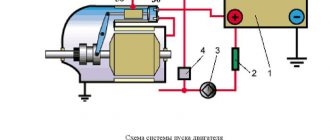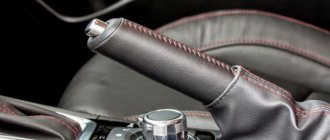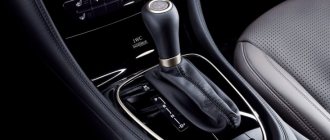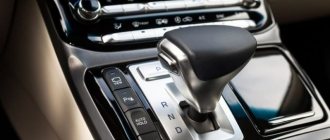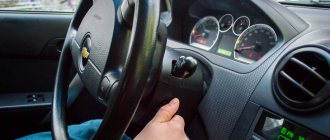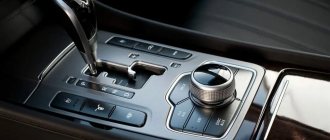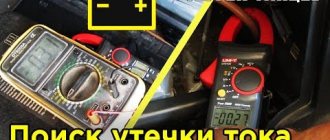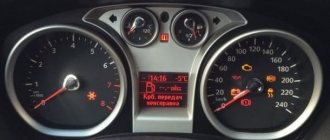Do you think it would be right to start the car automatically and drive it right away, or to let it run for a while? It’s like an athlete who doesn’t want to spend a lot of time warming up and rushes to train, but three days later he gets a muscle strain. The same thing happens with a car.
Many will say why waste extra gasoline, it’s already expensive. But the consequences of an incorrect launch will be even more expensive.
Rules for starting an engine with an automatic transmission
I have seen that most car enthusiasts, especially beginners, start driving the same way - from the first seconds of turning the ignition key, both in summer and in winter, without warming up either the engine or the automatic transmission.
Attention! There are differences between starting a diesel or gasoline engine. Therefore, the same incorrect actions in the car starting procedure will lead to problems not only in a car with an automatic transmission, but even the all-powerful mechanics cannot stand it.
Gas engine
My site often receives questions from new car owners who are interested in how to properly start a car with an automatic transmission. It all depends on what components the vehicle is stuffed with. Each car has one type of automatic transmission and the engines are also different: some are gasoline, some are diesel.
Therefore, the procedure for correctly starting a vehicle on an automatic with a gasoline engine is as follows:
- Insert the key into the ignition.
- Press the brake pedal.
- Set the selector knob to the “Parking” position.
- Start the engine using the key without pressing the brake pedal.
- Let the engine warm up for a while.
- Now move the automatic selector handle through all positions. This will allow the oil to reach the farthest nodes of the box, preparing it for a future trip. The approximate warm-up time is 5 minutes. If the machine’s temperature is displayed on the monitor, wait until it rises to 70 degrees.
- Release the brake pedal, move the selector knob to “D” mode and start driving.
Read
Parking with an automatic transmission: parking modes and proper parking with an automatic transmission for beginners
On a robot and a variator, it will be correct to set the selector handle not only to the “Parking” position, but also to “Neutral”. The car will not start in other modes, since it is specially protected from such a barbaric method of starting the car.
Diesel engine
All vehicles with a diesel engine are equipped with glow plugs. Therefore, to start a car with an automatic transmission on a diesel engine, proceed as follows:
- Get into the vehicle and insert the ignition key into the lock.
- Move the automatic transmission selector knob to the “Parking” position.
- Wait until the lamp indicating the operation of the glow plugs goes out on the monitor. If the temperature is below 20, then repeat heating the candles three times.
- Turn the key to start mode.
- Repeat the steps from steps 5 and 6 of the block dedicated to starting the machine on a gasoline engine.
- Release the brake pedal, move the selector knob to “D” mode and start driving.
Now you know how to start a car with an automatic transmission in summer or winter. The main thing is not to neglect these instructions, then the automatic transmission will last longer.
Attention! Any movement on an automatic transmission begins after pressing the brake pedal. For example, if you wanted to go backwards after moving forward, you pressed the brake pedal and moved the selector knob to the “R” mode and pressed the accelerator.
Additional modes
How to use an automatic transmission and how does it work?
Additional modes of automatic transmissions include:
- Winter mode is designated “*”, “W”, “SNOW”, “HOLD”, “WINTER”. According to it, slipping is eliminated when changing gears and when the vehicle starts moving. The car starts moving from second gear. Switching to other gears occurs at lower drive speeds - this eliminates fluctuations in the operation of the gearbox during acceleration and reduces the likelihood of the car skidding. Experts clarify: you should not use this mode in the summer - you can get the box overheated due to reaching the maximum load on the unit.
- The "D" position submodes limit acceleration above a certain gear range:
- “S” or “Z” - ensuring that the gear is not higher than third. These positions are used on sections of the road that require increased attention from the driver. When driving, use the “Z” mode, while monitoring the tachometer readings; its needle should not fall into the red zone.
- “2” - restriction of gear engagement no higher than second, the vehicle moves at a speed of no more than 80 km/h. Used on steep slopes and slippery roads.
- “1”, “L” - used for severe operating conditions of the machine: off-road driving, steep slopes. Transmission only, speed no more than 40 km/h.
Additional operating modes for automatic transmissions allow you to control the machine under unfavorable conditions. Please note: accidental activation of sub-modes “1”, “2” at high speed will lead to a sharp slowdown in the vehicle’s movement and will cause the vehicle to skid.
Car with automatic transmission won't start
Well, here we come to the most important problem that may be why you are here. The vehicle was working properly when you parked it in the garage. But you came to the garage in the morning to go to work, but you can’t start the car. There may be several reasons why she stopped obeying you:
- the battery is dead;
- problem in the motor;
- the machine fell into emergency mode;
- failure in the electronic control unit of the engine or automatic transmission.
Some of these problems can be solved on your own. To fix others you will have to contact a service center.
Reasons for automatic transmission
In an automatic transmission, the selector position sensor may be damaged. This happens with a machine gun from even a small “kiss” of the car with another vehicle. If you are absolutely sure that you did not “kiss” anyone, then there may be problems in the electronic control unit. Especially if the automatic transmission goes into emergency mode.
Read
Diagnostics and repair of automatic transmission selector position sensor
Sticking valves can also lead to emergency operation. If the car maintains the load during testing within 2500 rpm and 40 km/h and does not accelerate in this mode, then the problem is personally described. Regular flushing of the valve body will help.
Causes in the engine
The causes of engine failure may be low-quality oil, which is filled in by the car owner. Or malfunctions when starting a vehicle automatically are due to low-quality fuel, which is often dispensed at gas stations. It turns out that:
- throws out the candles. They cannot ignite a spark, and the vehicle does not move. Then it will be necessary to clean them;
- The engine filter becomes dirty. There is no air entering the motor. The filter needs to be replaced with a new one. I do not recommend washing the filter devices from the machine and the machine motor. It has been empirically proven that car owners who solve the problem of a dirty filter by washing come to the service center in a tow truck with a machine gun or engine thrown into the trash;
- Black smoke comes out of the exhaust pipe. Indicates poor fuel quality.
Another reason for the engine to idle is when the battery is discharged.
Causes in the battery
If the car's battery is old, it can discharge quickly. The rate of discharge is also affected by weather conditions. In severe frosts, the battery fails faster.
In batteries with a long service life, the plates sulfate and the electrolyte dries out. A discharged battery experiences constant voltage losses that prevent the starter from starting.
Lack of contact between terminals and wires. Therefore you need to check them.
Where to start?
It would seem that a car with an automatic transmission should perform all the main functions for the driver. But if a motorist is a beginner, naturally he wonders how to learn to drive an automatic car?
Instructions:
- Customization for yourself. When you get into a car, you should first of all adjust the seat to suit you in order to feel comfortable while driving. Check how the mirrors are configured and, if necessary, adjust them. Because when performing various maneuvers, it is necessary to constantly monitor the situation using the mirrors.
- Launch. In order to start the engine in operating condition, you need to turn the ignition key, then depress the brake pedal, and then switch the selector to the required mode. You need to remember that the car starts when the parking position is selected. After this, the drive position is selected, the brake pedal is removed and the car begins to move slowly.
- Movement. To accelerate the car to the desired speed, the gas pedal is already used. And if you need to make a forced stop, for example, in a traffic jam or at a traffic light, then you need to constantly press the brake pedal, otherwise the car will roll slowly. This is the peculiarity of the automatic transmission.
This factor is quite convenient. Because the car will not stall at the first start, and will not roll down on uneven roads.
Although many experienced motorists express many advantages in favor of mechanics, the latest automatic transmissions are gradually beginning to supplant established gearboxes. This is due to the fact that they have more and more advantages, for example, reduced fuel consumption. But still, everyone makes their choice in favor of where they will be more comfortable.
Why does my car battery drain?
The battery is discharged due to aging, short circuit, or poor-quality electrolyte. The car also has problems with a device called a generator. It does not produce the required amount of current.
Sulfation of plates
Sulfation of plates is a reduction in the porosity of lead walls. This creates a tendency for battery capacity to decrease. As a result, it does not hold electric current well, which is why the car may not start in severe frosts. If it is completely neglected, then the car may not start at all. All that remains is to replace the battery.
To detect sulfation, it is necessary to check the battery capacity. And to avoid reducing the porosity of the plates, the battery must be operated at low temperatures and not stored completely or half discharged.
Short circuit
A short circuit also leads to battery discharge. Usually occurs due to exposed wires that have been chewed by cats or mice. The wire is in contact with the machine body.
Read
Which is better and more reliable, CVT or automatic?
Another reason for a short circuit may be water that gets onto the terminals while washing a car or spilled electrolyte while refilling the battery, if the last one is being refilled. Although recently manufacturers have been making non-removable batteries with a long service life.
To avoid short circuits, keep the battery clean and check the wires for breaks at least once a month.
Shedding of active mass
The battery capacity depends on the amount of active mass. During the discharge, the capacity decreases, and the plates become covered with a coating of lead sulfate. If the battery is not charged for a long time, this deposit will corrode the plates.
The destruction of the plates occurs when shaken while the car is moving. Therefore, make sure that the battery is constantly charged and install it firmly and securely in the seats.
Problems with electrolyte characteristics
Contamination of the electrolyte, the entry of foreign particles into the battery - all this can lead to rapid discharge and failure of the device. Monitor the quality of the fluid if acc. dismountable - electrolyte can be added. If it is not removable, then buy a new battery.
Problems with the generator
A breakdown of the generator or its incorrect operation leads to the battery failing and the car not starting. There are mechanical breakdowns: then you will have to take the vehicle automatically to a service center.
If the problem is in the diode bridge, then you can solve it yourself. It gets exposed to moisture when driving into a deep puddle or oil from inaccurately pouring lubricant into the machine. The diode rectifier needs to be replaced.
To do this, remove the generator, test each diode individually, alternately changing the plus and minus on the multimeter. If it shows from infinity to 0.7 Ohm, then it is normal, if it is infinity in both cases, then replace the device.
Driving outside the city with an automatic transmission
Driving a car with an automatic transmission outside the city is in great demand. If you operate it correctly, the movement will be smooth, without jerking, with high-quality speed control. The transmission is almost specially designed for long distances, because the car itself chooses the position it needs.
Controlling an automatic transmission is not considered something very difficult and incredible. You won’t have to learn this method for a long time, because, as you know, it is much simpler than mechanics. The car practically drives itself, the gears switch automatically, and your foot sees only two pedals. Driving an automatic transmission is a simple process that is taught step by step in driving schools.
How to start a car if the battery is dead
Here I will talk about all the ways to start a vehicle on a half-dead battery. But some apply only to a vehicle with a manual transmission.
Lighting up
If you don’t know how to start a car with an automatic transmission with a dead battery, or are in doubt, then the only correct solution is to light it from another vehicle.
- Place two vehicles parallel to each other. Turn off the ignition on both.
- Connect the cigarette lighter terminals of the battery of the working vehicle and the one you want to start.
- Start the donor engine.
- Turn on the heated windows, radio - everything to reduce the load when disconnecting.
- Disconnect the negative wire from the terminal on the donor, then on the car from which it is lit. Then remove the positive terminal.
Read
13 inexpensive cars with automatic transmission
Proceed strictly according to the instructions. Otherwise, you can burn the starter and fuses.
Push launch
I do not recommend starting the vehicle with an automatic transmission using a pushrod. Although experienced car owners say that in mode n, for example, neutral is possible.
There is no direct contact between the engines and the wheels. All systems are down. When you stop suddenly, the machine takes the blow. After this method, the automatic transmission cannot be restored.
Starting using a ROM jumper charger
There are many designs and variations of ROM for starting a car with an automatic transmission:
- pulse;
- transformer;
- capacitor.
My advice is to purchase a pulse charger. With a shallow discharge, it will be enough to start the engine. And in deep conditions, you will have to wait a little while the battery is recharged. And the device itself is compact and will fit into the glove compartment of an automatic vehicle.
Starting with booster or lithium-ion battery
One type of ROM is boosters. These are a kind of power banks for car batteries. They supplement the battery with their charge and thereby help start the car. The best choice.
If your battery runs out in the wilderness, and you don’t know what to do or where to look for help, then having a charged booster in the glove compartment will bring the battery back to normal.
Start with fast charge
This type of launch is not always possible. It all depends on the condition of the car’s battery on the automatic transmission and the weather on the street where the car is parked. You can start with a quick charge only if there is absolutely nothing left.
Its essence lies in recharging with two ordinary single-core wires from the car, which is the cigarette lighter. There is a similarity to lighting a cigarette. But instead of the donor, the car starts and lights a cigarette. After ten minutes of operation it turns off.
Experts explain this method by the capacitor effect. The battery is charged just enough to start the engine the first time. More than that won't be enough. And it may lose capacity.
Attention! To fully charge the battery in a car in this case, you will have to drive for a long time.
Starting a car using a strap
I am often asked how to start a car with an automatic transmission using the sling method. That is, spin the crankshaft and transmission shaft manually on a raised wheel.
This method is not suitable for cars with automatic transmission, but is ideal for cars with manual transmission.
Read
Reasons why a car with an automatic transmission does not move forward or backward
Starting a car using a crooked starter
This method is ideal for those who have a dead battery in an old car. Modern vehicles with automatic transmissions do not have a hole under the starter curve.
Starting with alcohol
Another type of starting the starter on a vehicle with an automatic transmission if the battery is dead is called “drunk”. You can start the battery in this way only if it is dismountable. Pour white or red wine into the electrolyte containers and turn on the ignition.
A chemical reaction will begin. The voltage will increase and the engine will start.
Attention! This method should be used when you know for sure that you will throw away the battery when you arrive home. Since this method will completely kill the battery.
What method did you use? Please write in the comments.
Car battery
The battery requires special care and its service life depends on proper maintenance.
In the cold season, the battery loses up to 25% of its power, so before starting the engine it is necessary to give a “push” to the chemical reaction of the electrolyte; to do this, simply turn on the ignition for 2 - 3 minutes to warm up the electrolyte, and then proceed to start the engine.
By winter, it is advisable to bring the electrolyte density to 1.28 - 1.30 g/ cm3
, but by summer reduce the density to 1.26 - 1.27, thereby increasing the life of your battery. Always monitor the electrolyte level using the marks on the battery case and top up with distilled water in a timely manner.
It happens that the battery suddenly runs out, and there are no serviceable cars nearby, so what should you do? Quickly remove the terminals from the battery and wait 10 minutes, during which time disconnect the ground wire or any suitable wire to the generator (it can be connected by connectors).
The generator produces current both to charge the battery and for the general operation of the car's electrical appliances, so when starting the engine, it receives additional load from the generator, which makes it difficult for the engine to rotate.
If the generator is temporarily turned off, the engine rotation will be easier, which may be enough to start it. After starting the engine, try to reinstall the wire as quickly as possible, but carefully, so that the battery can be charged. If not, then you will have to use external physical force to push the car, and to make pushing easier, turn on the starter and help the engine gain a certain speed to start.
Sometimes they resort to unscrewing one or even two spark plugs from the 2nd and 4th cylinders in order to reduce compression and make it easier for the battery to operate. The engine can run on two cylinders if all is well.
But this option with spark plugs is not applicable to cars with electronic ignition, so it’s better not to take risks, otherwise you can burn the ignition coils.
Of course, the easiest way is with a pusher or trailer, just know that this method is only suitable for cars with a manual transmission.
But with an automatic pusher box, you can only break it and then change the box.
The best option is only if you “light” from another car, just make sure that the battery terminals on both cars are tightened and do not mix them up +
and – connecting wires and the “donor” car must be running.
If you already have a bad battery, then it is necessary to have special wires to “light” the battery, especially in winter. Although, every self-respecting driver should have wires and a tow rope.
Learn to start the car correctly and quickly, this is important for developing self-control in case you stall among a “crowd” of cars at a traffic light or in a traffic jam. Once you have practiced the exercise, you will no longer have a feeling of confusion and it will be easy for you to figure out what to do next. we will learn to move away
we will learn to move away.
How to extend battery life 6 useful tips for battery maintenance
Those batteries that are subject to repair and maintenance need to be looked after so that they last longer.
- Check for dust near the terminals or oxidation of the contacts. Collectively, these faults can lead to a short circuit.
- Try not to drive the vehicle short distances if it has been parked for a long time. The battery needs recharging.
- In winter, remove the battery or put a protective warm film on it if you leave the vehicle for a day or more.
- Protect the battery from deep discharges. Recharge once a month when not in use.
- Check the presence and condition of the electrolyte and lead plates.
- Take voltage readings from the battery. This will protect you from sudden battery drain when you need to go to an important meeting.
Tell us in the comments what you do to protect the battery from discharge and to ensure that the automatic vehicle always starts. Have you ever had a battery run out and what did you do?
Prepare your car for winter
To avoid freezing, your automatic transmission vehicle must be prepared for winter use.
- Replace the engine oil with a higher quality one suitable for use in winter weather conditions (clean oil makes it easier to start the engine).
- Purchase and install special accelerator additives. Fuel additives that improve the ignition ability of frozen fuel can make automatic starting easier.
- Check the condition of the battery, which should be replaced if it is unstable or has been in use for three years or more.
Take care of a garage (at least a simple and unheated one) for your car. Its presence will help your car survive the winter without freezing.
We haven’t had time to prepare the car for winter and the engine won’t start, then we need to revive the automatic transmission and increase the battery capacity. To do this you will have to use some proven methods.
How to start a car in winter?
- Turn on the low beam headlights for a short time. This action will warm up the electrolyte located in the battery, increasing the battery capacity. This should improve the efficiency of cranking a frozen engine.
- Inject a few grams of ether into the intake manifold, which is designed to facilitate engine starting in cold weather.
- Start the engine using the jump starter. In its absence, you can “light up” from a neighboring vehicle.
If all else fails, then you will have to walk/drive by public transport and warm up the engine with a blowtorch. When your automatic car warms up, you need to charge the battery at home, replace the spark plugs with dry ones and, if you have not done this already, prepare the car for winter use (check/replace the battery and change the oil).
Basic operating modes of automatic transmission
If you look closely at the selector (the block with the control lever and additional buttons), you can see various letters - “P”, “N”, “R”, “D”, “M”, “S” and others. They indicate operating modes and serve as prompts for the driver. To know how to drive an automatic transmission correctly, you need to understand the purpose of the modes.
The main operating modes of the automatic transmission are:
- “P” (from English Parking) - parking. In this mode, the car engine is disconnected from the transmission, the drive wheels are blocked (shaft blocking). The position is used to start the engine; also in this mode you can replace the parking brake if the car is parked on a slight slope.
- “R” (from the English Reverse) - reverse gear. The mode is intended for reversing and can only be activated after the vehicle has come to a complete stop.
- “N” (from the English Neutral) - neutral position. The engine is disconnected from the transmission and the drive wheels are not locked. Turns on during a short stop or to tow a vehicle for a short distance.
- “D” (from the English Drive) - forward movement. The main mode when traveling, used when driving under normal conditions.
- “M” (from the English Manual) - manual gear shifting. This mode is not available on all cars and is used when driving in difficult conditions: on a bad road or off-road, when braking the engine.
On some cars, often sports cars and positioned as such by the manufacturer, there is another main mode “S” (from the English Sport). It provides higher acceleration dynamics, which is why it is often used by fans of sports driving or when overtaking.
Possible consequences
When starting a car in any way not provided for by the operating rules, you need to know what the consequences are. Many people believe that such “fun of heroes” takes place without harm to the car. Actually this is not the case:
- There is a risk of damage to the clutch disc, since when the pedal is released, the transmission rotates, an impact occurs and the load on the disc and box increases.
- What gear is best to start in? It is forbidden to do this in reverse gear. It has the smallest gear, standing separately from the rest, and a weak synchronizer. The impact when starting the engine can cause the gearbox body to crack, especially in reverse gear. Save first gear too, second or third is better. These gears are stronger, which means the blow is easier to bear.
- Can the variator be damaged? It’s possible, starting from a pusher puts a strong load on any box.
- You can bend the valves only if the timing belt breaks. But the belt may not withstand a sharp jerk, especially if it has not been changed for a long time, or is very worn. Therefore, it is risky to push start a car with such a belt.
Tips and tricks
In fact, you should adhere to a simple rule: after the car has come to a complete stop, the selector is switched to mode P - “parking”, then the engine can be turned off. The engine is also started in this mode.
We also note that when starting the engine, as a rule, you should take the recommendation to press the brake pedal all the way (even on a car where starting the internal combustion engine is possible without such pressing). If the engine starts on an automatic transmission in “N” (neutral), then the brake must be released. We also recommend reading the article on how to operate an automatic transmission correctly. From this article you will learn about basic recommendations regarding the operation of an automatic transmission.
Also, after pressing the brake pedal, you can immediately switch from “parking” to modes “D” or “R”, as well as other modes, which is very convenient for quickly starting to move. The fact is that without pressing the brake pedal, you still won’t be able to turn on such modes.
Source
How to tow a car with automatic transmission
A car equipped with an automatic transmission cannot be towed for a long time with the engine switched off. Due to the design features, lubricant is supplied to the automatic transmission under pressure, which occurs only when the engine is running. Therefore, towing is only possible in neutral and with the engine running. Another option is to hang the front (drive) wheels.
If the transmission or engine does not work, the only way to transport the car from one place to another is with a tow truck. An exception will be some German models, which can be towed for a distance of no more than 50 km at a maximum speed of 50 km/h.
Features of cars with automatic transmission
An automatic transmission is a complex device that allows gear ratios to be switched without driver intervention. For a driver uninitiated in the technical intricacies, cars with manual transmission and automatic transmission are not much different: the gearbox control lever has different positions, and in a car with an automatic transmission there are only two pedals (gas and brake). As a result, it is easier for the driver to get moving; he does not need to be distracted by changing gears, which makes the driving process more comfortable.
A car with automatic transmission is not without its disadvantages:
- Fuel consumption increases in city traffic if the driver is inexperienced;
- most types of cars with automatic transmission cannot be towed for a long time on a flexible or rigid hitch; the front wheels must be suspended (only some modern models are exempt from this);
- you cannot overload the vehicle and it is not advisable to attach a trailer to it (a minus for summer residents and residents of rural areas who traditionally use a passenger car instead of a truck);
- the need for more careful maintenance;
- high cost of repairs in case of automatic transmission failure.
The principle of driving a car with an automatic transmission differs in many ways from a manual one. In order to know how to change gears on an automatic transmission, you need to have an idea of its operating modes and operating features in different conditions. Most drivers don’t know about this, which is why they stop at car repair shops more often than they otherwise would.
